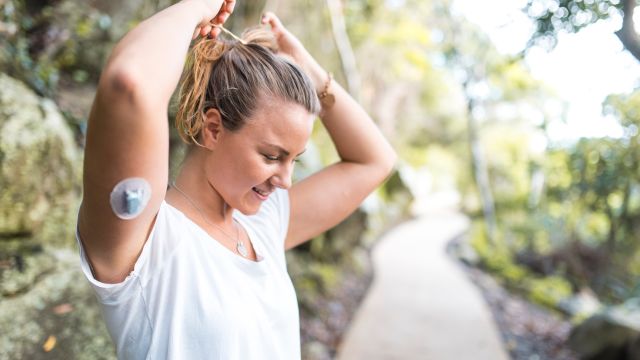Updated on March 15, 2024.
If you live with type 1 or type 2 diabetes, exercising is one of the best things you can do for your health. Staying physically active helps you:
- Manage your blood sugar levels (the amount of sugar in your blood that comes from the food you eat)
- Prevent insulin resistance (when your body has trouble moving sugar from your blood into your cells where it can be used for energy)
- Improve your lipid levels (meaning you can lower your levels of LDL “bad” cholesterol, raise levels of HDL “good” cholesterol, and reduce triglycerides, a fat-like substance found in the blood)
- Control blood pressure (the force of circulating blood pushing against the walls of your blood vessels)
- Lose extra weight (even losing a few extra pounds can have health benefits)
Regular workouts also lower your risk of depression and improve sleep. They can help you maintain strength, flexibility, and strong bones, too.
Sometimes caution is necessary
While exercise is good for your diabetes, it may lead to problems for some people. For example, it could cause blood sugar levels to drop. This may affect your sense of balance. Weight-bearing exercise (such as lifting weights) can raise the risk of injury to legs and feet, too. This risk is higher if you have nerve damage caused by diabetes, a condition called diabetic neuropathy.
But exercise can also prevent or slow neuropathy, since it improves blood flow and helps to manage blood sugar levels.
So, what should you know about exercising?
"Diabetes doesn't mean you can't exercise or even become an athlete," says Bob Greene, author of The Best Life Guide to Managing Diabetes and Pre-Diabetes. "It just means that you have to be sure to get the right combination of medications, carbohydrates, and calories to keep blood sugar in a safe zone while exercising."
Here are tips to stay safe when you work out.
Guidelines for exercising with diabetes
Some exercises may be dangerous for people with certain health issues. It's always best to talk to a healthcare provider (HCP) before starting a new fitness regimen. They can help you choose activities that are right for you, whether that might mean walking or jogging.
Then, consider the following:
Check your blood sugar levels before you exercise
To ensure a safe workout, test your blood sugar 30 minutes before starting. This step is very important if you're taking insulin.
- If your blood sugar level is from 100 to 250 mg/dL, you are okay to begin.
- If it’s lower than 100 mg/dL, eat a small snack high in carbohydrates. Options include whole-grain bread, crackers, or fruit.
- If it’s higher than 250 mg/dL, you may have high ketones (substances that your body makes when it does not have enough of the hormone insulin to help sugar go from your bloodstream into your cells and produce energy). High ketones can make your blood too acidic. Don’t exercise until your blood sugar levels are within a safe range.
Individual ranges can vary based on your type of diabetes and medications. Check with your HCP for specific guidance and include it in your diabetes action plan.
Check your blood sugar levels again when you finish
Exercise can lower blood sugar for up to 24 hours after you work out. Once you’re done with your routine, check your blood sugar levels again. Check it more often than usual over the next 24 hours, too. If needed, eat something or take insulin to balance your blood sugar.
Prepare for a drop in blood sugar
Your blood sugar could drop during a workout. Test yourself once you feel it starting to drop. Make sure to bring a carbohydrate source with you, too. That way, you can treat the low. This is very important for people with type 1 diabetes who take insulin.
Protect your feet
Wear protective athletic shoes, like sneakers, that can absorb impact. Make sure they fit so you can avoid blisters, which can get infected. If needed, add insoles for extra cushioning. If you have neuropathy and weight-bearing exercise is difficult for you, swimming may be a wiser choice. Ask your HCP what type of shoes are right for you and whether your health insurance may help cover the cost.
Wear fabrics that breathe
Fungal infections like athlete’s foot are more common in people with diabetes. So choose clothes and socks that let your skin breathe. Look for labels that say "moisture-wicking" and use socks with no seams. Synthetic fabrics (man-made products like polypropylene, polyester, and acrylic) are popular choices for exercise clothes because they help pull sweat away from your body. If you wear cotton shirts, shorts, and pants, choose sizes that aren’t too tight.
Stay hydrated
Dehydration (not having enough fluid in your body) causes blood sugar levels to rise. To avoid this, drink plenty of water before and during your exercise session. The American Council on Exercise recommends drinking 17 to 20 ounces of water two to three hours before your workout. During your workout, they suggest drinking 7 to 10 ounces of water every 20 minutes.
Choose water whenever possible instead of sports drinks labeled "zero-calorie" or "sugar-free." If you are exercising for an extended time, consider a sports drink with electrolytes and carbohydrates. It may help keep blood sugar levels steady.
Beware of exercising in extreme heat
Very hot weather can make you sweat a lot. This can lead to dehydration and higher blood sugar levels. So, try to exercise at cooler times of the day, such as early morning or evening. If you are indoors, choose air-conditioned rooms if possible. Avoid heated areas and “hot” activities, such as Bikram yoga.
Bring a cell phone if you have one
In case of emergency, you can call for help. Be sure to wear something that signals that you have diabetes, too. Consider a medical ID tag, bracelet, or necklace.







